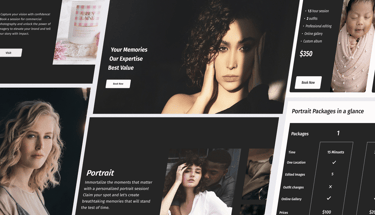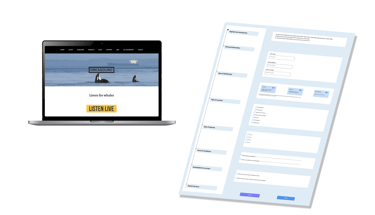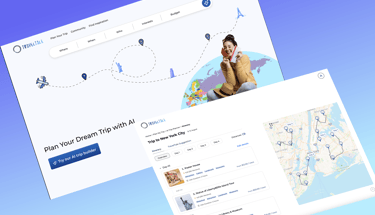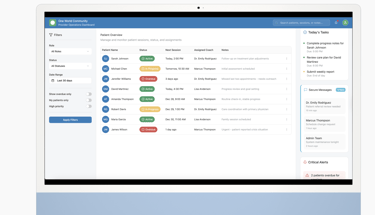This is a short story of how I led the design of an accessible dashboard that helps healthcare teams collaborate and care with clarity.

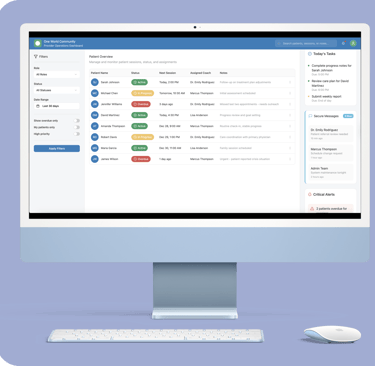
One World Community
Team and Their Roles:
UX Lead (Me) – Directed the research and design process end-to-end. I led stakeholder interviews, facilitated workshops, synthesized data, and created the final dashboard design.
UX Researcher(James) – Supported user research by helping document interview findings, organizing workshop notes, and assisting in synthesizing insights for testing and design validation.
Visual Designer(May) – Refined the final UI using our color and accessibility guidelines, ensuring the interface met WCAG and brand standards.
Developer(Chris) – Partnered with design to review feasibility, ensure technical alignment, and prepare components for implementation.
Overview
Clinicians, recovery coaches, and admins all needed a way to stay connected while supporting people in recovery. But they were using different tools; they relied on tools such as Google Sheets, Zoom notes, and Slack messages for updates, leading to missed information and inconsistent records.
Important details were often missed, and some information wasn’t shared safely. There was no single place to see each person’s progress or what needed attention next.


As the UX Lead, my goal was to guide a cross-functional team through research, workshops, and design to deliver a HIPAA-compliant dashboard that simplified complex workflows without sacrificing security or empathy.
Research & Discovery
Because this project involved multiple roles with different goals — clinicians, coaches, admins, and compliance- we needed a discovery process that brought all voices together early.
Stakeholder Interviews – to understand each role’s daily tasks, challenges, and how they currently share information.
LUMA Stakeholder Mapping – to visualize relationships and data flow between roles and uncover where communication breaks down.
Workflow Mapping – to connect all findings into one clear view of the current process and identify where the dashboard could simplify or automate steps.
Stakeholder Interviews


Stakeholder Mapping

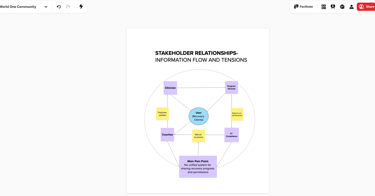
To understand how each role worked and where communication broke down, I conducted stakeholder interviews with clinicians, recovery coaches, admins, and compliance staff.
The goal was to hear directly from those managing recovery programs — what tools they used, how they shared updates, and what made their work harder than it needed to be.
Outcome
The interviews revealed three main problems shared across roles:
No shared visibility — clinicians, coaches, and admins tracked client progress in separate tools, leading to missed updates.
Manual data entry and reporting — repeated work caused delays and errors.
Unclear access and permissions — people often couldn’t see the information they needed, or had to wait for approval.
These findings shaped the dashboard’s priorities: create one secure place where every role can see, update, and share information without friction.
To see how the different roles interacted, I led a LUMA Stakeholder Mapping workshop with clinicians, recovery coaches, admins, and compliance staff.
We mapped how information, approvals, and updates flowed between them — and where communication broke down.
This method helped us understand who’s involved and where communication breaks down.
Outcome
The map exposed overlapping responsibilities and missing handoffs:
Clinicians and coaches duplicated notes because they used separate tracking tools.
Admins and compliance handled approvals manually, slowing updates.
Program directors lacked a single, reliable source for progress data.
These patterns made it clear that we needed a centralized, role-based dashboard — one system that connects all roles while keeping access secure and compliant.
Workflow Mapping
After the interviews and stakeholder mapping, I created a Workflow Map to trace how information moved between roles — from intake to follow-up.
This visual helped the team see where data got stuck, duplicated, or delayed.
By mapping the entire process, we identified the exact points where a shared dashboard could save time and reduce errors.
Outcome
The mapping revealed:
Information gaps between clinicians and coaches during client updates.
Manual handoffs between admins and compliance teams for approvals.
No real-time visibility into client progress for directors and care teams.
These insights directly informed the dashboard’s structure — automated status updates, permission-based views, and clear progress tracking for every role.


Design Phase
Based on our research, our goal was to make the work easier and clearer for everyone using the dashboard.
We focused on four main things:
One shared place – So all roles can see and update information together.
Less manual work – Fewer repeated tasks and faster reports.
Better visibility – Everyone can quickly see what’s happening and what needs attention.
Accessible and secure – Easy to use for all, while keeping data safe.


This was the first round of wireframes exploring how each role might interact with the dashboard.
At this stage, the layout was consistent across all roles — clinicians, coaches, admins, and compliance staff — with only the content blocks changing slightly.
We wanted to see if a unified structure could work for everyone.
First Wireframe – Initial Concept
After testing the first wireframes with a small group of clinicians, coaches, and admins, we learned that the design felt familiar — but not functional enough for their daily needs.
Key Findings
Similar layouts caused confusion.
Users said every role’s dashboard “looked the same,” which made it unclear what to focus on.“I don’t know if this is my view or the coach’s view — everything looks identical.”
Information density was uneven.
Clinicians wanted fewer cards and more session details, while admins wanted a broader overview.Tasks were disconnected from real data.
The “Tasks” and “Notes” sections didn’t pull directly from patient sessions, forcing users to duplicate updates.Alerts lacked urgency
Users ignored alerts because they weren’t visually distinct or prioritized..
Usability Findings & Changes
Iteration Timeline
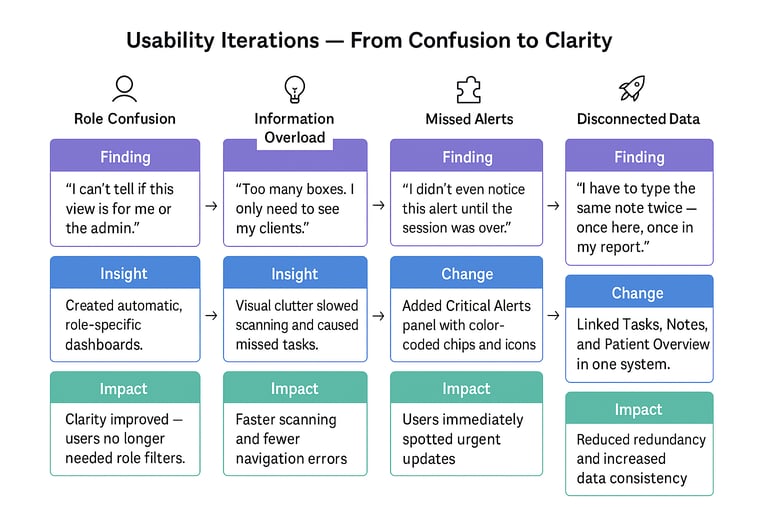

This is the Visual summary showing how usability findings guided the evolution from the first wireframes to the final, role-based dashboard.
Final Design
Every element in the final dashboard was shaped by usability feedback and the daily needs of clinicians, coaches, and admins.
The goal wasn’t to make the interface prettier — it was to make it work smarter.
Why This Layout
We kept the three-column grid to balance overview and action.
The center column holds the patient table — the team’s main workspace — while the right column focuses on next steps and alerts. This layout supports quick scanning and reduces page switching.
Why a Centralized Table
During testing, most users spent time looking for the same information: session status, assigned coach, and next visit.
A single Patient Overview Table made it easier to see everything at once, cutting the number of clicks by half.
Why a Task + Alert Panel
The right-hand panel gives a clear picture of what needs immediate attention.
Users said they often missed follow-ups in the old version, so alerts were moved to a fixed, high-contrast area visible on every screen.
Why Accessibility Was Prioritized
Since this system would be used across healthcare roles, it had to meet WCAG 2.1 AA standards.
High-contrast text, large touch targets, and color-independent status cues ensure that all users — including those with visual limitations — can use the dashboard comfortably.
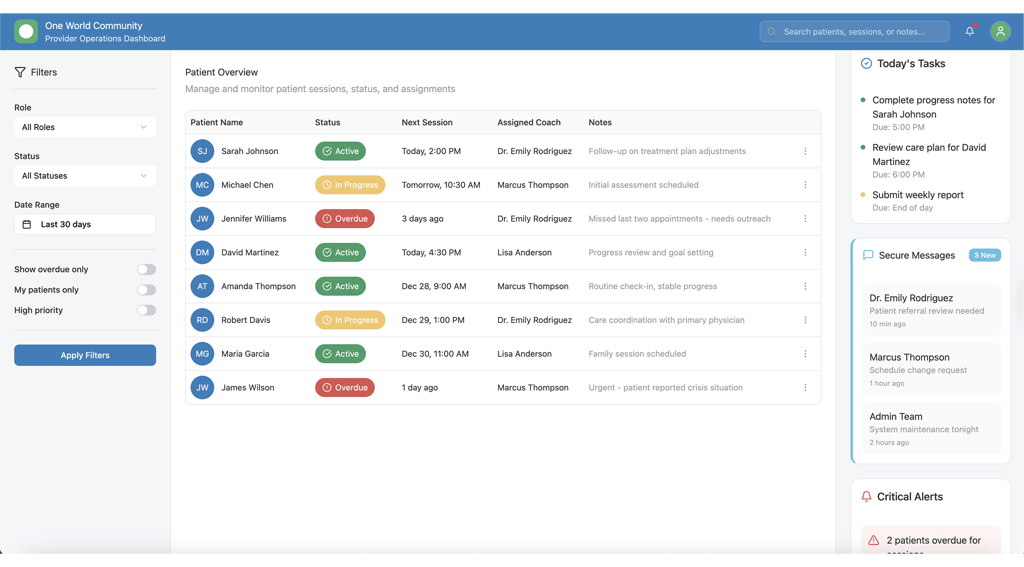

Impact & Team Reflection
The redesign improved both the user experience and the way our team worked together.
After the final round of usability testing, we ran a quick Rose–Thorn–Bud workshop to reflect on what worked, what didn’t, and what could grow next.
40% faster task completion for clinicians and admins.
Reduced duplicate data entry by linking notes, tasks, and reports.
90% of users found the new dashboard easier to navigate.
95% WCAG 2.1 AA compliance, ensuring accessibility for all team members.
Product Impact
Team Reflection
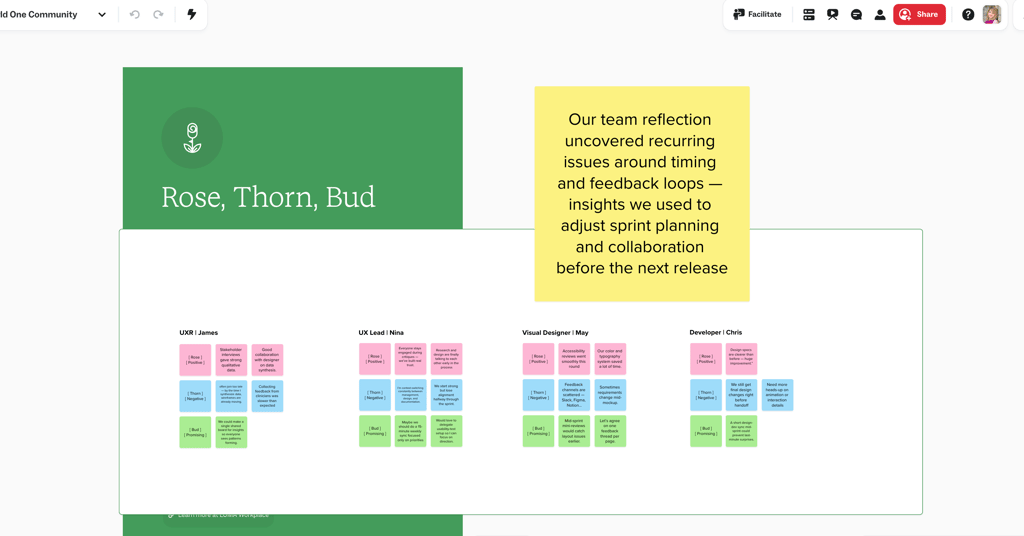

The Rose–Thorn–Bud helped us close the loop — turning lessons from this project into action for the next.
Just like the dashboard evolved from messy to clear, our workflow did too.
Next Steps & Takeaways
Leading this project taught me that good UX design isn’t just about making interfaces easier — it’s about aligning people, processes, and purpose.
Through research, workshops, and iteration, I learned how even small design decisions can remove daily friction for teams working under pressure.
Our next step is to extend the dashboard to include reporting and analytics tools, giving leaders real-time visibility into program outcomes.
But the biggest win wasn’t just the final design — it was building a shared understanding between clinicians, coaches, and developers of what clarity truly means in a healthcare system.
Our UX team (UX Lead, UXR, Visual Designer, Developer) used this quick session to reflect on our process.
We wanted to see what was working, what slowed us down, and where we could improve collaboration before the next sprint.

